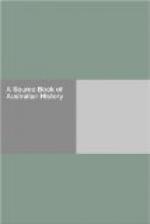PART I
DISCOVERY AND EXPLORATION
DISCOVERY OF TASMANIA
+Source.+—Tasman’s Journal (edited by Heeres), pp. 1, 11-16
The Spaniard Torres was probably the first European to sight Australia (Cape Yorke); but Tasman was the first who consciously discovered the Great South Land. In his search for fresh fields for trade, he came upon Tasmania and New Zealand.
Journal or description drawn up by me, Abel Jan tasman, of a Voyage made from the town of Batavia in E. India for the discovery of the unknown Southland, in the year of our Lord 1642, the 14th of August. May God Almighty vouchsafe his Blessing on this work. Amen.
Note.—Days reckoned from midnight to midnight. Longitude calculated from meridian of Peak of Teneriffe.
Item the 23rd Nov.—Good weather with a south-easterly wind and a steady breeze; in the morning, we found our rudder broken at top in the tiller hole; we therefore hauled to windward under reduced sail and fitted a cross beam to either side. By estimation the west side of Nova Guinea must be North of us.
Item the 24th do. Good weather and a clear sky. In the afternoon about 4 o’clock we saw land bearing East by North of us; at about 10 miles distance by estimation. The land we sighted was very high. Towards evening we also saw S.S.E. of us three high mountains, and to the N.E. two more mountains, but less high than those to southward. This land being the first we have met with in the South sea and not known to any European nation, we have conferred on it the name of Anthoony Van Diemenslandt, in honor of the Hon. Governor-General, our illustrious master, who sent us to make this discovery; the islands circumjacent so far as known to us, we have named after the Hon. Councillors of India.
Item 28th do. In the evening we came under the shore. There are under the shore some small islands one of which looks like a lion.
Item 29th do. In the morning were still near the rock which looks like a lion’s head. Towards noon passed two rocks; the most westerly looks like Pedra Branca, which lies on the coast of China, the most easterly, looking like a high rugged tower, lies about 16 miles out from the mainland. Ran through between these rocks and the land. We came before a way which seemed likely to afford a good anchorage upon which we resolved to run into it. We again made for the shore, the wind and current having driven us so far out to sea that we could barely see the land.
Item 1st Dec. We resolved that it would be best and most expedient to touch at the land, the sooner the better; both to get better acquainted with the land and secure refreshment for our own behoof. About one hour after sunset we dropped anchorage in a good harbour, for all of which it behooves us to thank God Almighty with grateful hearts.




